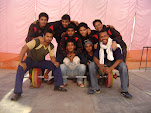The reason for all these posts is to put fundaes to junta on gymming rather than suggesting a routine. If you understand what and how it works, you can be more confident about your workouts.
If you want to know how muscle is built, http://en.wikipedia.org/wiki/Muscle_hypertrophy
The body has several muscle groups. A usual classification is into majors and minors....
Major muscle groups:
1. Legs
2. Back
3. Chest
4. Shoulders
Minor muscle groups:
1. Triceps
2. Biceps
3. Forearms
4. Abs
Most commonly, beginners are suggested to work majors when they first hit gym. This is because minors are under stress when majors are worked out- minor muscle groups have to support the load when you're working majors.
There are a lot of fundaes on this, like division into agonists, antagonist and synergist, depending on the way each muscle is worked when during a certain exercise. It is good to know these too, but can be postponed for a later stage. To put in a nutshell, agonists are main muscles responsible for a movement while antagonists act in the opposite movement- like biceps and triceps when you bend or straighten your elbow. Synergists are the side muscles that help in the movement. Usally, the antagonists support the movement. If you're more interested, check this- http://en.wikipedia.org/wiki/Agonist_(muscle)
Any muscular action should happen about a joint. There is either flexion- decreasing joint angle or extension
- increasing joint angle. For instance, the triceps are worked when the elbow joint is extended and the biceps are worked when the elbow is flexed.
Muscles can only take contraction, i.e. they are very good at pulling, not good at pushing or stretching. When you flex your arm, the biceps are contracted and triceps are extended, hence your biceps are worked out. The opposite when you extend- the arm has to be pulled by the triceps when extending, hence triceps are worked.
In any proper exercise, the muscle has to be properly extended and contracted. If you're doing a biceps curl, you have to straighten your elbows completely and then bend them completely and compress the biceps muscle as much as possible.
Conclusion:
1. You grow muscle when you put it under a lot of stress first and then allow it to recover and then build more muscle. So, workout in the gym for a max of one hour, and then rest each muscle group for atleast 72 hours for majors and 48 hours for minors.
2. Muscles take time to recover grow. Don't work out for more than 4 days a week. In extreme cases, if you have great recovering ability, you may go 5 days a week, though it is not advisable. 3 days a week is a good start for beginners. Do cardio for 2 more days a week and take complete rest for 2 days.
2. The minors are synergists to major muscle group movements. So you don't need to work the minors when you're just beginning.
3. Identify the agonists and synergists for a certain movement. See if you're really working the agonist. If you're not sure, ask someone who knows. It is always the best thing to ask the coach or someone who really knows.
4. For best results, do complete movements. Straighten the joint completely and then compress the muscle at the other end. Don't take this literally, but understand the implications.
5. This is for a later stage, but if you do opposing movements alternatively, like pushing and pulling, you allow the muscles to recover while you're working out. Don't take this for granted, but do remember this.
Very very important:
Your muscle, recovery period, endurance limits and your strength have a lot to do with your genetics. You can see a lot of gifted guys- big and strong, in the gym. They have huge muscles when they haven't really worked out properly. A lot of such guys say arbitrary things about how you need to work out. DO NOT LISTEN TO THEM. Whatever worked for them worked because they're already naturally strong. Ask someone who has proper fundaes or better, look in wikipedia or youtube.

No comments:
Post a Comment